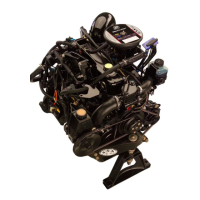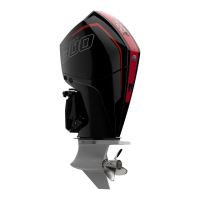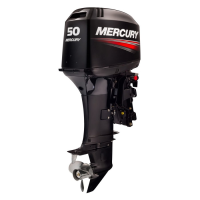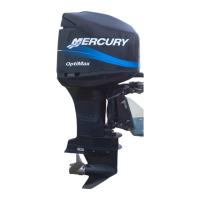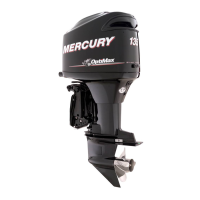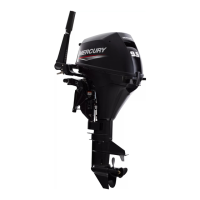90-826148R2 MARCH 1997 IMPORTANT INFORMATION - 1C-1
Serial Number Location
The Outboard serial number is located on the lower
starboard side of the engine block. A serial number
is also located on the starboard side of the swivel
bracket.
19XX
XX
OGXXXXXX
XXXX
a
e
d
c
b
a - Serial Number
b - Model Year
c - Model Description
d - Year Manufactured
e - Certified Europe Insignia
Conditions Affecting
Performance
Weather
It’sa known fact that weather conditions exert apro-
found effect on power output of internal combustion
engines. Therefore, established horsepower ratings
refer to the power that the engine will produce at its
rated RPM under a specific combination of weather
conditions.
Corporations internationally have settled on adop-
tion of I.S.O. (International Standards Organization)
engine test standards, as set forth in I.S.O. 3046
standardizing the computation of horsepower from
dataobtainedonthedynamometer,correctingallval-
ues to the power that the engine will produce at sea
level, at 30% relative humidity at 77° F (25° C) tem-
perature and a barometric pressure of 29.61 inches
of mercury.
Summer conditions of high temperature, low baro-
metric pressure and high humidity all combine to re-
duce the engine power. This, in turn, is reflected in
decreased boat speeds--as much as 2 or 3 miles-
per-hour (3 or 5 Km per-hour) in some cases. (Refer
to previous chart.) Nothing will regain this speed for
the boater, but the coming of cool, dry weather.
In pointing out the practical consequences ofweath-
er effects, an engine--running on a hot, humid sum-
mer day--may encounter a loss of as much as 14%
of the horsepower it would produce on a dry, brisk
spring or fall day. The horsepower, that any internal
combustion engine produces, depends upon the
density of the air that it consumes and, in turn, this
densityisdependentuponthetemperatureoftheair,
itsbarometricpressureandwatervapor(orhumidity)
content.
Accompanyingthisweather-inspiredlossofpoweris
asecondbutmoresubtleloss.Atriggingtimeinearly
spring,theenginewasequippedwitha propellerthat
allowed the engine to turn within its recommended
RPM range at full throttle. With the coming of the
summer weather and the consequent drop in avail-
ablehorsepower,thispropellerwill,ineffect,become
too large. Consequently, the engine operates atless
than its recommended RPM.
Duetothehorsepower/RPMcharacteristicsofanen-
gine, this will result in further loss of horsepower at
the propeller with another decrease in boat speed.
This secondary loss, however, can be regained by
switching to a smaller pitch propeller that allows the
engine to again run at recommended RPM.
For boaters to realize optimum engine performance
under changing weather conditions, it is essential
that the engine have the proper propeller to allow it
tooperateatornearthetopendoftherecommended
maximum RPM range at wide-open-throttle with a
normal boat load.
Not only does this allow the engine to develop full
power, but equally important is the fact that the en-
gine also will be operating in an RPM range that dis-
courages damaging detonation. This, of course, en-
hances overall reliability and durabilityof the engine.
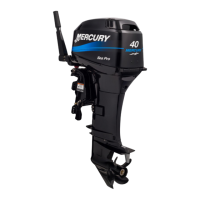
